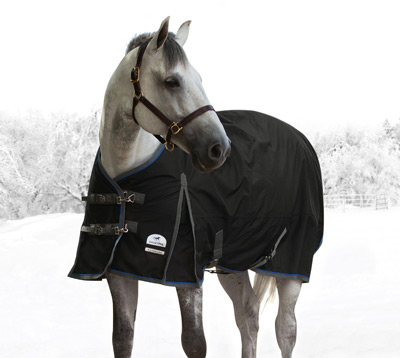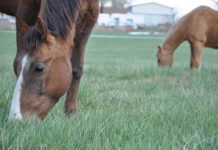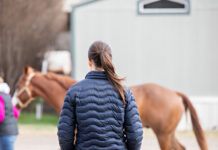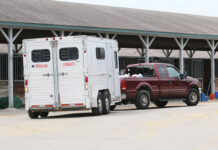 Liz Russell, corporate communications specialist with Dover Saddlery, offers the following blanket fit checkpoints:
Liz Russell, corporate communications specialist with Dover Saddlery, offers the following blanket fit checkpoints:
- Start by fastening the chest closure. The fabric at the chest should be able to overlap, with the buckle or clip adjustment somewhere near the middle. When the chest closure is fastened appropriately, the tail seam should sit at the point where you want the blanket to end. Some people prefer the tail portion to be long enough to form a tent over the top of the horse’s tail. Other people prefer to have their horse’s blanket or sheet stop just short of the tail, especially for stable wear.With these points in place, you should be able to slide your hand under the blanket all around the neck and over the withers with your horse’s head lowered (as if to graze) and when it is raised. If the neck opening is too large or too wide, then your horse could get its foot caught in it while lying down or rolling, and it may rub your horse’s shoulders. If it is too tight, it will cause the blanket to pull or rub the withers, mane or points of the shoulders or tug at the base of the neck.
- If the blanket seems appropriate after step 1, adjust the belly surcingle(s). Your blanket may have a belly band, two bias (angled) surcingles that should cross under the belly or one or two straight surcingles. No matter what type you have, these straps should be set so that you can slide only one flat hand between the strap and the belly. If you can fit more than this, then there is enough room for a horse’s leg to become entangled while lying down or rolling. Less than this amount of space can cause the blanket to rub the horse.
- If the blanket has leg straps, then pass the left strap through the horse’s hind legs and clip it to the dee ring on the left side of the blanket. Cross the right leg strap through the left leg strap and clip it to the dee ring on the right side. These straps should be adjusted so that you can fit only one hand’s width between the strap and the inside of the leg. If they are too long and hang down to the horse’s hocks, then a leg can become entangled. If the straps are too short, they may inhibit movement and may rub the tender insides of the gaskin or groin area.
- If the blanket has a tail strap, it should be adjusted so that you have about a hand’s width between the strap and the horse.
- With fastenings done, stand back and look at the overall effect of the clothing on your horse. The shoulders of the blanket should not be stretched tightly over your horse’s shoulders, yet the blanket should not appear too large either. The hem should not hang at the horse’s knees or below.
Field Guide to Horse Blanket Styles
Back to Blanket Central >>







Great tips.